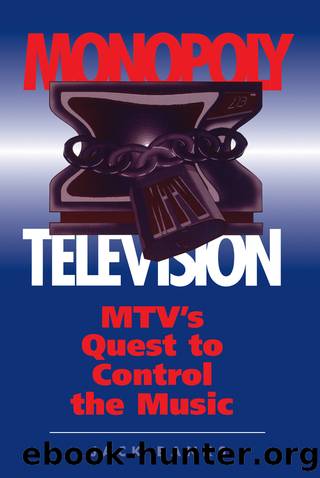Monopoly Television by Jack Banks

Author:Jack Banks [Banks, Jack]
Language: eng
Format: epub
Tags: Social Science, General, Sociology
ISBN: 9780429978470
Google: NJVLDwAAQBAJ
Publisher: Routledge
Published: 2018-02-12T03:35:52+00:00
Video Replaces Touring in Promotional Strategies
Before MTV, the record labels regularly financed tours for their new artists to cultivate a following. In the 1970s, record companies often required artists to do a series of live performances concurrently with the release of a new album to increase sales of the artists' records in a local area. However, by the early 1980s the major labels largely stopped subsidizing tours, leading Larry Fitzgerald, a manager of Toto, to say, "The term 'tour support' really doesn't exist anymore."13 Record labels became skeptical about the promotional benefits of tours and questioned whether live performances really increased record sales. Label executives' enthusiasm for tours was also dampened by rapidly increasing tour expenses and mediocre concert attendance, which limited revenues. This disenchantment with tours combined with the growing popularity of video music gradually led the major record labels to favor video music over live tours as a way to promote their artists. Eddie Rosenblatt, president of Geffen Records, praised videos, saying, "The good news is that a band that used to go on the road for six weeks and play in front of 10,000 people now can have a video on MTV and immediately be seen by millions of kids."14
In the early 1980s, concert promoters predicted gloomily that music video would eventually undermine touring by artists. Music consumers, it was argued, would prefer to watch their favorite artists on television in the convenience of their own homes rather than pay to see a live concert. However, program services such as MTV did not adopt an adversarial approach to tours, but rather developed a supportive stance toward live performances by actively promoting tours by featured artists. MTV, VH-1, and other services publicize upcoming tours through on-air promotions and special programming involving the artist. MTV regularly develops extensive campaigns for U.S. tours by popular acts that include frequent mention of concert dates, heavy play of the artists' videos, live reports by the veejays from the concerts, and other programming featuring the artists. For instance, MTV and VH-1 gave extensive publicity to The Rolling Stones' 1994 Voodoo Lounge tour, incessantly hawking concert souvenirs in home-shopping programs.
The growing prominence of video music did have an impact on artists' live performances, but not in the manner predicted. Music video did not destroy concerts, but instead influenced the form and content of actual performances. Pop stars attempt to replicate the imagery, special effects, and choreography of their videos in live concerts. Madonna and Michael Jackson both stage elaborate concerts that recreate prominent scenes from their videos. These attempts by artists to make concerts resemble their video music productions make some live performances more rigidly structured and preplanned, draining the concert of any potential spontaneity. Artists make use of their videos in various ways within their concerts, such as presenting music clips in lieu of an opening act. The centerpiece of the stage for concerts by Duran Duran, a group whose commercial success was largely created by video music, was a $300,000 "video wall"
Download
This site does not store any files on its server. We only index and link to content provided by other sites. Please contact the content providers to delete copyright contents if any and email us, we'll remove relevant links or contents immediately.
Whiskies Galore by Ian Buxton(41935)
Introduction to Aircraft Design (Cambridge Aerospace Series) by John P. Fielding(33085)
Small Unmanned Fixed-wing Aircraft Design by Andrew J. Keane Andras Sobester James P. Scanlan & András Sóbester & James P. Scanlan(32763)
Craft Beer for the Homebrewer by Michael Agnew(18193)
Turbulence by E. J. Noyes(7977)
The Complete Stick Figure Physics Tutorials by Allen Sarah(7334)
Kaplan MCAT General Chemistry Review by Kaplan(6896)
The Thirst by Nesbo Jo(6876)
Bad Blood by John Carreyrou(6580)
Modelling of Convective Heat and Mass Transfer in Rotating Flows by Igor V. Shevchuk(6406)
Learning SQL by Alan Beaulieu(6235)
Weapons of Math Destruction by Cathy O'Neil(6204)
Man-made Catastrophes and Risk Information Concealment by Dmitry Chernov & Didier Sornette(5951)
Digital Minimalism by Cal Newport;(5698)
Life 3.0: Being Human in the Age of Artificial Intelligence by Tegmark Max(5506)
iGen by Jean M. Twenge(5384)
Secrets of Antigravity Propulsion: Tesla, UFOs, and Classified Aerospace Technology by Ph.D. Paul A. Laviolette(5330)
Design of Trajectory Optimization Approach for Space Maneuver Vehicle Skip Entry Problems by Runqi Chai & Al Savvaris & Antonios Tsourdos & Senchun Chai(5036)
Pale Blue Dot by Carl Sagan(4947)
